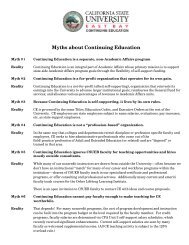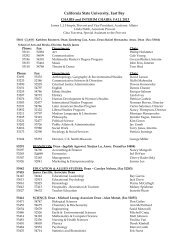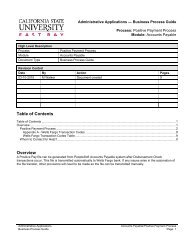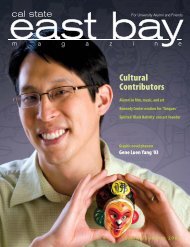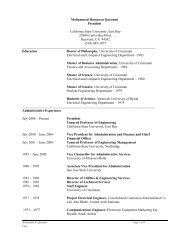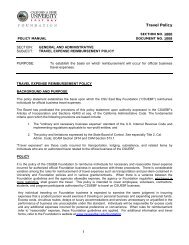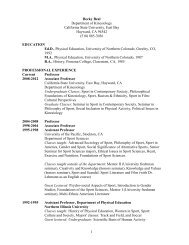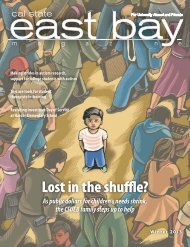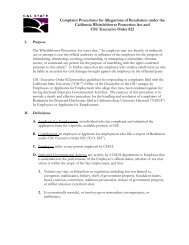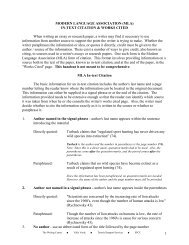Fall 2011 - California State University, East Bay
Fall 2011 - California State University, East Bay
Fall 2011 - California State University, East Bay
You also want an ePaper? Increase the reach of your titles
YUMPU automatically turns print PDFs into web optimized ePapers that Google loves.
features<br />
“<br />
There’s got to be joy, even at the end<br />
of life. Good food is important to<br />
people, and that doesn’t go away just<br />
because you’re 85 years old.<br />
”<br />
Sue Graziano Adams ’90<br />
Founder, Blossom Foods<br />
That sort of message reinforces one of Adams’ core beliefs: “There’s got to be joy, even<br />
at the end of life,” she says. “Good food is important to people, and that doesn’t go away just<br />
because you’re 85 years old.”<br />
Blossom Foods’ business has doubled in customers and gross profit every year since<br />
2005. The growth, Adams believes, is the result of the company’s emphasis on freshness and<br />
flavor. Everything at Blossom Foods is fresh-frozen, even though other processes such as<br />
canning would simplify storage and shipping. Canned foods, Adams explains, are emulsified,<br />
which produces a gritty texture and a watery, sometimes metallic taste that Adams finds<br />
unacceptable. “When you put our food in your mouth, it still has good texture,” she says.<br />
“You don’t have to chew it, but your mouth naturally manipulates it.” This, she explains,<br />
gives the diner an experience closer to that of eating unprocessed food.<br />
Blossom Foods also improves its diners’ experience by expanding their choices. While<br />
sticking to tried-and-true foods like ravioli and cherry cobbler, the company is steadily<br />
expanding its international offerings. "(For) one hospital in Fremont … we're trying things like<br />
chicken marsala and eggplant parmigiana," Adams says. “If we get them as a (regular) customer,<br />
we’ll also try offering these dishes on the Internet.” In all cases, quality is foremost: Every new<br />
recipe is taste-tested by an eight-person flavor<br />
panel, evaluated for nutritional value, and<br />
approved by the USDA, if it includes meat.<br />
Spreading the word<br />
Adams begins her long workday at 3:30<br />
a.m., when she processes online orders,<br />
answers e-mail, and plans production and<br />
shipments for commercial customers from her<br />
home in Oakland. Later in the morning she<br />
drives her green Range Rover (with the vanity<br />
plate 2PUREE) to the Blossom Foods kitchen<br />
to oversee operations. When she returns to<br />
the <strong>East</strong> <strong>Bay</strong> in the early afternoon — she<br />
insists on picking up her kids from school —<br />
she often delivers meals to a hospital along<br />
the way. “I’ve done every job here,” she says,<br />
including cooking, packaging, shipping, and<br />
cleaning up.<br />
Today, Blossom Foods is “about at our<br />
limit as a small company,” Adams says, so<br />
she’s contemplating steps to grow the business<br />
while maintaining high quality. She’d like to<br />
work with a large food service distributor,<br />
which would make her products available to<br />
more hospitals. She’s also thinking of taking<br />
on investors. And she’d love to see Blossom<br />
Foods in retail freezers nationwide. “They’ve<br />
got 600 types of frozen pizza,” she says with<br />
exasperation. “But you cannot find textured<br />
food there.<br />
“My daughter asked me the other day,<br />
‘Mom, why didn’t you invent Vitamin Water?’<br />
(She loves Vitamin Water.),” Adams says. “But<br />
I told her, people aren’t writing to Vitamin<br />
Water saying we need another darn drink, but<br />
they write to me every day.”<br />
So as long as her in-box overflows with<br />
requests for Blossom Foods’ creamed spinach,<br />
ground shepherd’s pie, and puréed bread<br />
pudding, Adams will stick to her mission:<br />
to feed Blossom Foods fans — and their<br />
renewed enthusiasm for mealtime. n<br />
FIRM MARKET<br />
for SOFT FOOD<br />
According to the American Speech-<br />
Language-Hearing Association<br />
(www.asha.org), the prevalence of<br />
dysphagia, or swallowing difficulty,<br />
may be as high as 22 percent in people<br />
over 50; the prevalence increases with<br />
age. Some dysphagia is caused by<br />
neurologic disorders such as stroke,<br />
Parkinson’s disease, multiple sclerosis,<br />
and amyotrophic lateral sclerosis (ALS).<br />
Traumatic brain injury and cerebral palsy<br />
can also cause dysphagia, as can tumors<br />
of the head, neck, and esophagus.<br />
In addition to people with dysphagia,<br />
people who have laparoscopic adjustable<br />
gastric band (lap-band) surgery for<br />
weight loss often require puréed food.<br />
Typically, these patients eat pureed food<br />
for 30 to 90 days after the procedure.<br />
22 Cal <strong>State</strong> <strong>East</strong> <strong>Bay</strong> Magazine | FALL <strong>2011</strong><br />
Cal <strong>State</strong> <strong>East</strong> <strong>Bay</strong> Magazine | FALL <strong>2011</strong><br />
23





